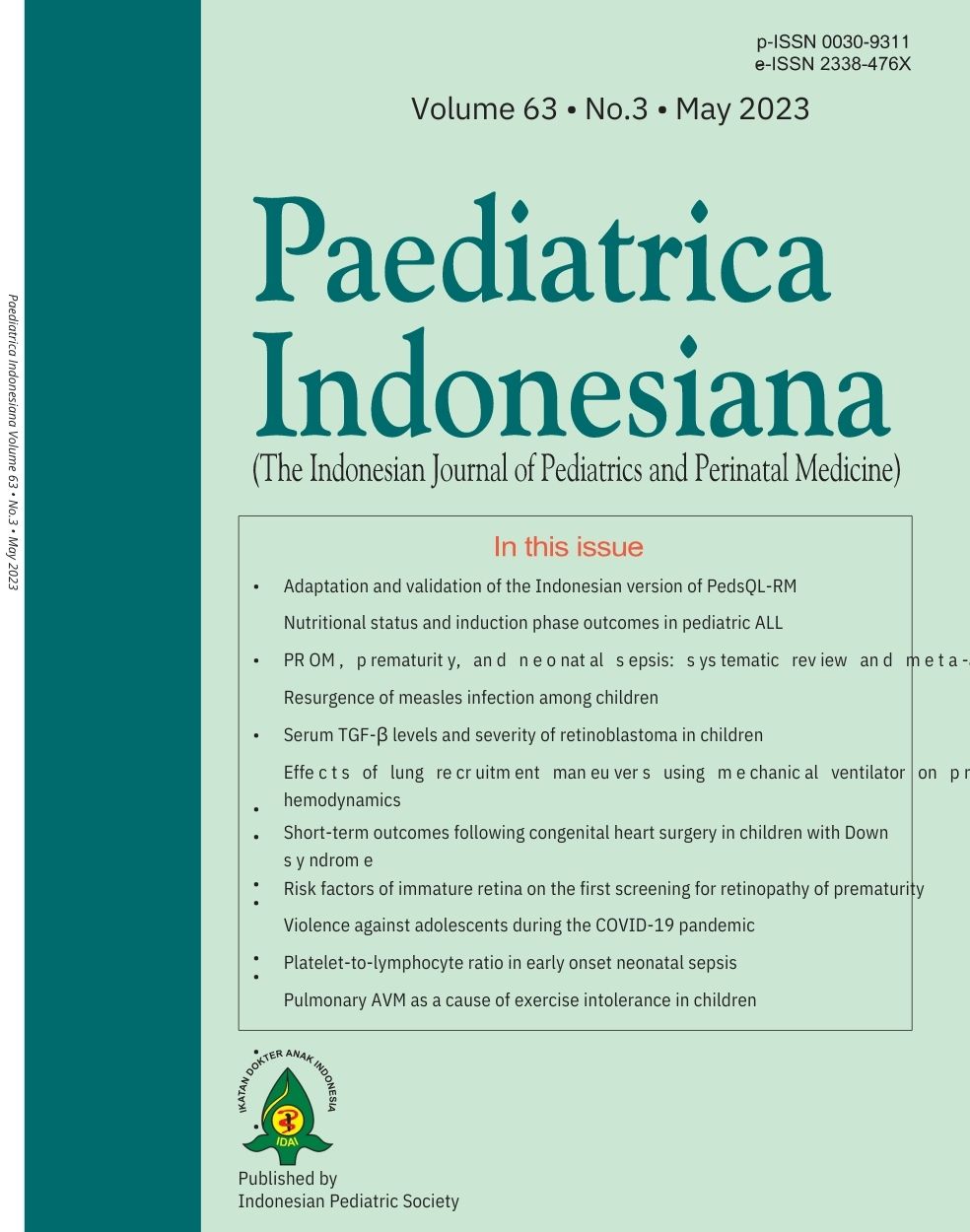Risk factors of immature retina on the first screening for retinopathy of prematurity
Abstract
Background Immature retina is characterized by peripheral retinal avascularity. Retinal development is influenced by risk factors that affect retinal maturity.
Objective To identify risk factors for immature retina on the first retinopathy of prematurity (ROP) screening at the Neonatology Care Unit, Al-Islam Hospital, Bandung, in 2013-2021.
Methods This case-control, retrospective, observational study was performed by evaluating medical records of preterm infants screened for ROP. The subjects were divided into two groups, immature retina and mature retina. We recorded potential risk factors including gestational age (GA), birth weight (BW), birth weight for gestational age, respiratory distress syndrome (RDS), oxygen therapy >7 days, asphyxia, sepsis, multiple transfusion, apnea of prematurity (AOP), patent ductus arteriosus (PDA), and bronchopulmonary dysplasia (BPD) and analyzed them for potential associations with retinal development.
Results On the first ROP screening of 203 premature infants, 5 (2.5%) had ROP, 90 (44.6%) had immature retinas, and 107 (53.0%) had mature retinas. Bivariate logistic regression analysis showed significant relationships between immature retina (P<0.05), GA (OR=0.575; P=0.000), BW (OR=0.997; P=<0.001), gestational age maturity (OR=2.639; P=0.006), RDS (OR=1.809; P=0.042), oxygen therapy of >7 days (OR=4.494; P=0.002), sepsis (OR=2.028; P=0.034), multiple transfusions (OR=4.656; P=0.000), AOP (OR=2.553; P=0.002), PDA (OR=2.119; P=0.030). Multivariate regression analysis revealed a significant simultaneous relationship between all the risk factors and immature retina, with a Nägelkerke R2 value of 0.421.
Conclusion GA, BW, gestational age maturity, oxygen therapy of >7 days, sepsis, multiple transfusions, AOP, and PDA are significant risk factors of immature retina, be it independently or simultaneously.
References
2. Lee TC, Chiang MF. Pediatric retinal vascular diseases. In: Ryan SJ, Hinton DR, Sadda SR, Wiedemann P, Schachat AP, Wilkinson CP, eds. Retina. 5th ed. Elsevier; 2013 [cited 2022 Sep 25]. p. 1108–28. Available from: https://linkinghub.elsevier.com/retrieve/pii/B9781455707379000618 DOI: https://doi.org/10.1016/C2010-1-69566-1.
3. Goldenberg RL, Culhane JF, Iams JD, Romero R. Epidemiology and causes of preterm birth. Lancet. 2008;371:75–84. DOI: https://doi.org/10.1016/S0140-6736(08)60074-4
4. Blencowe H, Lawn JE, Vazquez T, Fielder A, Gilbert C. Preterm-associated visual impairment and estimates of retinopathy of prematurity at regional and global levels for 2010. Pediatr Res. 2013;74(S1):35–49. DOI: https://doi.org/10.1038/pr.2013.205.
5. World Health Organization. Blindness and Deafness Unit & International Agency for the Prevention of Blindness. (?2000)?. Preventing blindness in children: report of a WHO/IAPB scientific meeting, Hyderabad, India, 13-17 April 1999. [cited 2022 Nov 25]. Available from: https://apps.who.int/iris/handle/10665/66663.
6. Badriah C, Amir I, Elvioza E, Ifran E. Prevalence and risk factors of retinopathy of prematurity. Paediatr Indones. 2012;52:138-44. DOI: https://doi.org/10.14238/pi52.3.2012.138-44.
7. Gong A, Anday E, Boros S, Bucciarelli R, Burchfield D, Zucker J, et al. One-year follow-up evaluation of 260 premature infants with respiratory distress syndrome and birth weights of 700 to 1350 grams randomized to two rescue doses of synthetic surfactant or air placebo. American Exosurf Neonatal Study Group I. J Pediatr. 1995;126:S68–74. DOI: https://doi.org/10.1016/S0022-3476(95)70010-2.
8. Schalij-Delfos NE, Cats BP. Retinopathy of prematurity: the continuing threat to vision in preterm infants: Dutch survey from 1986 to 1994. Acta Ophthalmol Scand. 1997;75:72–5. DOI: https://doi.org/10.1111/j.1600-0420.1997.tb00254.x.
9. Scott E. Disorders of the retina and vitreous. In: Kliegman RM, Geme JS, Editor. Nelson Textbook of Pediatrics. 9th ed. Philadelphia: Elsevier; 2012. p. 2174–81.
10. Jayadev C, Vinekar A, Bharamshetter R, Mangalesh S, Rao H, Dogra M, et al. Retinal immaturity at first screening and retinopathy of prematurity: image-based validation of 1202 eyes of premature infants to predict disease progression. Indian J Ophthalmol. 2019;67:846-53. DOI: https://doi.org/10.4103/ijo.IJO_469_19.
11. Fielder AR, Quinn GE. Retinopathy of prematurity. In: Taylor & Hoyt's pediatric ophthalmology and strabismus. 5th ed. New York: Elsevier; 2017. p.506–24.
12. Thanos A, Drenser KA, Capone A. Retinopathy of prematurity. In: Yanoff Duker Opthalmology. 5th ed. New York: Elsevier; 2019. p. 537–41.
13. The Committee for the Classification of Retinopathy of Prematurity. An International Classification of Retinopathy of Prematurity. Arch Ophthalmol. 1984;102:1130–4. DOI: https://doi.org/10.1001/archopht.1984.01040030908011
14. Al Rashaed S. Retinopathy of prematurity—a brief review. Dr Sulaiman Al Habib Med J. 2019;1:58-64. DOI: https://doi.org/10.2991/dsahmj.k.191214.001.
15. Jang JH, Kim YC. Retinal vascular development in an immature retina at 33–34 weeks postmenstrual age predicts retinopathy of prematurity. Sci Rep. 2020;10:18111. DOI: https://doi.org/10.1038/s41598-020-75151-0.
16. Mutlu FM, Sarici SU. Treatment of retinopathy of prematurity: a review of conventional and promising new therapeutic options. Int J Ophthalmol. 2013;6:228–36. DOI: https://doi.org/10.3980/j.issn.2222-3959.2013.02.23.
17. Shah PK, Narendran V, Kalpana N, Gilbert C. Severe retinopathy of prematurity in big babies in India: history repeating itself? Indian J Pediatr. 2009;76:801–4. DOI: https://doi.org/10.1007/s12098-009-0175-1.
18. Vinekar A, Gilbert C, Dogra M, Kurian M, Shainesh G, Shetty B, et al. The KIDROP model of combining strategies for providing retinopathy of prematurity screening in underserved areas in India using wide-field imaging, tele-medicine, non-physician graders and smart phone reporting. Indian J Ophthalmol. 2014;62:41-9. DOI: https://doi.org/10.2147/EB.S98715.
19. Siswanto JE, Sauer PJ. Retinopathy of prematurity in Indonesia: incidence and risk factors. J Neonatal Perinatal Med. 2017;10:85–90. DOI: https://doi.org/10.3233/NPM-915142.
20. Azami M, Jaafari Z, Rahmati S, Farahani AD, Badfar G. Prevalence and risk factors of retinopathy of prematurity in Iran: a systematic review and meta-analysis. BMC Ophthalmol. 2018;18:83. DOI: https://doi.org/10.1186/s12886-018-0732-3.
21. Hartnett ME, Penn JS. Mechanisms and management of retinopathy of prematurity. N Engl J Med. 2012;367:2515–26. DOI: https://doi.org/10.1056/NEJMra1208129.
Copyright (c) 2023 Wedi Iskandar Kartamihardja

This work is licensed under a Creative Commons Attribution-NonCommercial-ShareAlike 4.0 International License.
Authors who publish with this journal agree to the following terms:
Authors retain copyright and grant the journal right of first publication with the work simultaneously licensed under a Creative Commons Attribution License that allows others to share the work with an acknowledgement of the work's authorship and initial publication in this journal.
Authors are able to enter into separate, additional contractual arrangements for the non-exclusive distribution of the journal's published version of the work (e.g., post it to an institutional repository or publish it in a book), with an acknowledgement of its initial publication in this journal.
Accepted 2023-06-30
Published 2023-06-30













